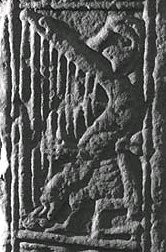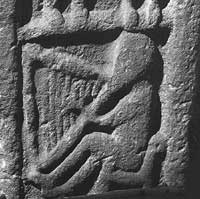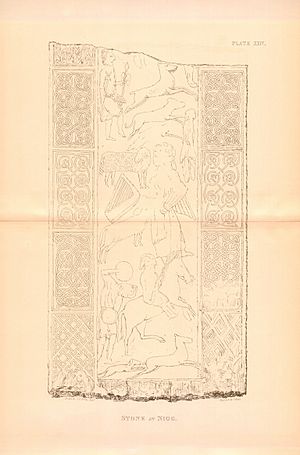Origin of the harp in Europe facts for kids
Have you ever wondered where the harp came from? The triangular frame harp, which is the kind of harp we usually think of today, has a bit of a mystery around its beginnings. Pictures of triangular instruments held by people have been found in old art from places like Ireland, Scotland, England, Wales, and other parts of northwest Europe. Experts don't all agree on where it first appeared, and this article will tell you about some of their different ideas.


Contents
Scottish Harp Origins
Scotland has a very old connection with stringed instruments. A part of a bridge from an Iron Age lyre was found on the Isle of Skye. This piece is about 2,300 years old, making it the oldest stringed instrument found in Western Europe.
The very first pictures of a European triangular frame harp are on Pictish stones from the 8th century. Pictish harps used strings made from horsehair. These instruments then seemed to spread south to the Anglo-Saxons, who often used strings made from animal gut. Later, they moved west to the Gaels in the Scottish Highlands and to Ireland.
There are only thirteen known pictures of any triangular stringed instrument from before the 11th century in Europe. Twelve of these thirteen pictures come from Scotland. Also, the oldest Irish word for a harp is 'cruit'. This word suggests that the instrument might have come from the Picts.
Only two square-shaped instruments are seen in Irish art on the west coast of Scotland. Both of these carvings are from about 200 years after the Pictish carvings. The first clear pictures of the Irish triangular harp don't show up until the late 11th century. These are found on a special container for holy objects called a reliquary. They appear on stone carvings in the 12th century.
The earliest harps used in Ireland were square lyres, often used in churches. One idea is that the Pictish stone carvings might have been copied from the Utrecht Psalter. This is a famous book from the early 9th century. The Utrecht Psalter is the only other place outside Pictish Scotland that shows a triangular stringed instrument.
However, the Nigg Stone in Scotland has a carving of a triangular instrument from 790–799 AD. This means it was made about 35 to 40 years before the Utrecht Psalter. Other Pictish sculptures also came before the Utrecht Psalter. For example, the harper on the Dupplin Cross is from around 800 AD.
French Harp Origins
Some of the earliest drawings of triangular-frame harps are found in a book called the Utrecht Psalter. This book was written and illustrated in the early 9th century in Rheims, France. Ten of the pictures in the book show people holding instruments that look like harps. In six of these pictures, you can clearly see the front pillar of the harp.
The Utrecht Psalter was created between 816 and 835 AD. It later traveled to a writing center at Christ Church in Canterbury, England, around 970 AD. Several copies of the book were made there. Before this time, religious books in Europe often showed King David playing a stringed instrument. However, older books usually showed him with a medieval lyre, not a harp.
Harps in the Utrecht Psalter
Similar Irish Instruments
In Ireland, stone carvings of instruments are mostly found in Christian settings. Most of these carvings show lyres or square-shaped church instruments. These carvings date from the 8th to the 12th century. However, lyres are physically different from triangular harps. It's unlikely that the well-known medieval harp developed from them.
Early Irish monasteries valued using lyres in church services. The instruments shown in carvings come in different shapes and sizes. They tend to be lyres rather than the typical triangular harps. Old Irish hymn texts mention that hymns and psalms were sung with a lyre. These square instruments were used in religious ceremonies because they were small. This practice began when Christianity came to Ireland.
Gerald of Wales, a writer, mentioned the "Cythera" (Kithara) of St Kevin. He said Irish abbots and bishops played it for chants and funeral songs. These instruments were highly valued in Ireland even into the 12th century.
From an Irish point of view, there are three main types of lyres:
- Round top lyres: These are seen in carvings at Ullard. They show a square instrument with no front pillar. Round top lyres were common across northern Europe between the 5th and 10th centuries. Examples have been found, like in the Sutton Hoo treasure.
- Curved arm lyres: These are shown on the Cross of Scriptures at Clonmacnoise, the West Cross at Kells, and the Cross at Castletown, County Offaly.
- Oblique lyres: These are depicted on the South Cross at Kells, the Crosses of Muirdach, and Monasterboice.
The carving at Monasterboice, County Louth, does show a type of triangular instrument. However, the stone is worn, and it's not clear if the figure is playing a true triangular harp. Some think it looks a lot like the Ullard lyre.
Another study argues that many crosses from the time before the Normans arrived still exist in Ireland. What's interesting is that none of them show triangular frame harps. Some old texts mention "coir-cethar-chuir," which means 'four-angled music'. This refers to a four-sided instrument. Other Irish sources from that time, like the Cotton manuscript, still show a plucked lyre. These match the lyre on the shrine of St Maelruain Gospel, the Durrow Cross lyre, and the three-stringed lyre carving of the Judgment of Solomon at Ardmore Cathedral.
The first clear pictures of the Irish triangular harp don't appear until the late 11th century. This is on the St. Moedoc shrine. The Gospel of St Maelruain from the same time still traditionally shows a lyre with three strings. Other articles suggest the triangular harp first appeared in Ireland when the Anglo-Norman invasion began.
The arrival of English harpers in Ireland is also recorded in old books. The Dublin Merchant roll (around 1190-1265) shows a group of English Anglo-Norman harpers in Ireland. They were playing in the Anglo-Norman style. A sketch from around 1200 shows one of these musicians, Thomas Le Harpur, playing a triangular English harp. It's not clear if this arrival led to a mixing of styles between the invading Anglo-Norman and Irish harpers.
Pre-European Harp Origins
The ideas and designs for harps and lyres likely came to ancient Europe from the Middle East. For example, a 5,000-year-old Sumerian lyre is on display at the British Museum. This might have happened as early as the peak of the Celtic civilization. A lyre fragment found at the High Pasture Cave site in Scotland is from about 300 BC.
It makes sense to connect this finding with the wide-ranging contacts that Celtic peoples had. At their biggest expansion in the 4th century BC, Celts had connections with southeastern Europe. Lyres and similar instruments were very common there. For example, Orpheus, the most famous lyre-player in Greek stories, was from Thrace. This region is between Greece and Anatolia. This connection might also relate to the migration of Celtic tribes (Galatians) to Anatolia in 278 BC.









